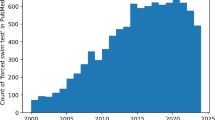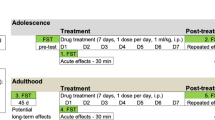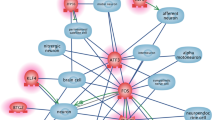Abstract
Wistar–Kyoto (WKY) rats provide a model of stress-induced depressive behavior, because they show enhanced vulnerability to the effects of stressors. The present study examined differences in the behavioral response to different types of antidepressant drugs between WKY and Sprague–Dawley (SD) rats in the forced swimming test (FST). WKY rats displayed significantly greater immobility than SD rats during their exposure to the FST. The noradrenergic antidepressant, desipramine, produced a dose-dependent reduction of immobility and increase of climbing behavior in the SD rats. In WKY rats, desipramine reduced immobility at a lower dose and produced increases of both swimming and climbing behavior. The serotonergic compounds, fluoxetine and 8-OH-DPAT, produced dose-dependent reductions of immobility and increases of swimming behavior in the FST in SD rats, but the response to the serotonergic drugs were blunted in WKY rats. These results indicate that genetic or constitutive differences may determine the distinct behavioral profiles for antidepressant compounds with selective pharmacological effects in different rat strains, and these effects may be related to genetic heterogeneity of antidepressant responses in depressed patients.
Similar content being viewed by others
Log in or create a free account to read this content
Gain free access to this article, as well as selected content from this journal and more on nature.com
or
References
Armario A, Gavalda A, Marti J . (1995): Comparison of the behavioral and endocrine response to forced swimming stress in five inbred strains of rats. Psychoneuroendocrinology 20: 879–890
Berger DF, Starzic JJ . (1988): Contrasting lever-press avoidance behavior of spontaneously hypertensive and normotensive rats (rattus norvegicus). J Comp Psychol 102: 279–286
Borsini F, Lecci A, Sessarego A, Frassine R, Meli A . (1989): Discovery of antidepressant activity by forced swimming test may depend on pre-exposure of rats to a stressful situation. Psychopharmacology 97: 183–188
Borsini F, Meli A . (1988): Is the forced swimming test a suitable model for revealing antidepressant activity? Psychopharmacology 94: 147–160
Detke MJ, Johnson J, Lucki I . (1997): Acute and chronic antidepressant drug treatment in the rat forced swimming test model of depression. Exp Clin Psychopharmacol 5: 107–112
Detke MJ, Lucki I . (1995): Detection of serotonergic and noradrenergic antidepressants in the rat forced swimming test: The effects of water depth. Behav Brain Res 73: 43–46
Detke MJ, Rickels M, Lucki I . (1995): Active behaviors in the rat forced swimming test differentially produced by serotonergic and noradrenergic antidepressants. Psychopharmacology 121: 66–72
Duncan GE, Paul IA, Harden TK, Mueller RA, Stumpf WE, Breese GR . (1985): Rapid down-regulation of beta adrenergic receptors by combining antidepressant drugs with forced swim: A model of antidepressant-induced neural adaptation. J Pharmacol Exp Ther 234: 402–408
Heninger GR, Delgado PL, Charney DS . (1996): The revised monoamine theory of depression: A modulatory role for monoamines, based on new findings from monoamine depletion experiments in humans. Pharmacopsychiatry 29: 2–11
Jonsson EG, Nothen MM, Gustavsson JP, Neidt H, Bunzel R, Propping P, Sedvall GC . (1998): Polymorphisms in the dopamine, serotonin, and norepinephrine transporter genes and their relationships to monoamine metabolite concentrations in CSF of healthy volunteers. Psychiat Res 79: 1–9
Kirby LG, Lucki I . (1997): Interaction between the forced swimming test and fluoxetine treatment on extracellular 5-hydroxytryptamine and 5-hydroxyindoleacetic acid in the rat. J Pharmacol Exp Ther 282: 967–976
Lahmame A, Armario A . (1996): Differential responsiveness of inbred strains of rats to antidepressants in the forced swimming test: Are Wistar–Kyoto rats an animal model of subsensitivity to antidepressants? Psychopharmacology 123: 191–198
Lahmame A, del Arco C, Pazos A, Yritia M, Armario A . (1997): Are Wistar–Kyoto rats a genetic animal model of depression resistant to antidepressants? Eur J Pharmacol 337: 115–123
Lesch K-P . (1997): Molecular biology, pharmacology, and genetics of the serotonin transporter: Psychobiological and clinical implications. In Baumgarten HG, Gothert M (eds), Serotoninergic Neurons and 5-HT Receptors in the CNS. Berlin, Springer. pp 670–705
Lucki I . (1997): The forced swimming test as a model for core and component behavioral effects of antidepressant drugs. Behav Pharmacol 8: 523–532
Lucki I, Singh A, Kreiss DS . (1994): Antidepressant-like behavioral effects of serotonin receptor agonists. Neurosci Biobehav Rev 18: 85–95
Marti J, Armario A . (1996): Forced swimming behavior is not related to corticosterone levels achieved in the test. A study with four inbred rat strains. Physiol Behav 59: 369–372
Okamoto K, Aoki K . (1963): Development of a strain of spontaneously hypertensive rats. Japan Circ J 27: 282–293
Overstreet DH, Rezvani AH, Janowsky DS . (1992): Genetic animal models of depression and ethanol preference provide support for cholinergic and serotonergic involvement in depression and alcoholism. Biol Psychiat 31: 919–936
Page ME, Detke MJ, Dalvi A, Kirby LG, Lucki I . (1999): Serotonergic mediation of the effects of fluoxetine, but not desipramine, in the rat forced swimming test. Psychopharmacology in press.
Paré WP . (1989): Behavioral despair test predicts ulceration in WKY rats. Physiol Behav 46: 483–487
Paré WP . (1990): Technique and strain comparisons in stress ulcer. Ann NY Acad Sci 597: 223–230
Paré WP . (1992): Learning behavior, escape behavior, and depression in an ulcer-susceptible rat strain. Integrat Physiol Behav Sci 27: 130–141
Paré WP . (1993): Passive-avoidance behavior in Wistar–Kyoto (WKY), Wistar, and Fischer-344 rats. Physiol Behav 54: 845–852
Paré WP . (1994): Open field, learned helplessness, defensive burying, and forced-swim tests in WKY rats. Physiol Behav 55: 433–439
Paré WP . (1996): Enhanced retrieval of unpleasant memories influenced by shock controllability, shock sequence, and rat strain. Biol Psychiat 39: 808–813
Paré WP, Redei E . (1993): Depressive behavior and stress ulcer in Wistar–Kyoto rats. J Physiol (Paris) 87: 229–238
Paré WP, Tejani-Butt SM . (1996): Effect of stress on the behavior and 5-HT system in Sprague–Dawley and Wistar–Kyoto rat strains. Integr Physiol Behav Sci 31: 112–121
Paul IA, Duncan GE, Kuhn C, Mueller RA, Hong JS, Breese GR . (1990): Neural adaptation in imipramine-treated rats processed in forced swim test: Assessment of time course, handling, rat strain, and amine uptake. J Pharmacol Exp Ther 252: 997–1005
Porsolt RD, Le Pichon M, Jalfre M . (1977): Depression: A new model sensitive to antidepressant treatments. Nature 266: 730–732
Porsolt RD, Anton G, Deniel M, Jalfre M . (1978): Behavioral despair in rats: A new model sensitive to antidepressant treatments. Eur J Pharmacol 47: 379–391
Rénéric J-P, Lucki I . (1998): Antidepressant behavioral effects by dual inhibition of monoamine reuptake in the rat forced swimming test. Psychopharmacology 136: 190–197
Rosetti ZL, Lai M, Hmaidan Y, Gessa GL . (1993): Depletion of mesolimbic dopamine during behavioral despair: Partial reversal by chronic imipramine. Eur J Pharmacol 242: 313–315
Tejani-Butt SM, Paré WP, Yang J . (1994): Effect of repeated novel stressors on depressive behavior and brain norepinephrine receptor system in Sprague–Dawley and Wistar–Kyoto (WKY) rats. Brain Res 649: 27–35
Valentino RJ, Foote SL, Page ME . (1993): The locus coeruleus as a site for integrating corticotropin-releasing factor and noradrenergic mediation of stress responses. Ann NY Acad Sci 697: 173–188
Van der Heyden JAM, Molewijk E, Olivier B . (1987): Strain differences in response to drugs in the tail suspension test for antidepressant activity. Psychopharmacology 92: 127–130
Wieland S, Boren JL, Consroe PF, Martin A . (1986): Stock differences in the susceptibility of rats to learned helplessness. Life Sci 39: 937–944
Wieland S, Lucki I . (1990): Antidepressant-like activity of 5-HT1A agonists measured with the forced swim test. Psychopharmacology 101: 497–504
Acknowledgements
We greatly appreciate the comments of Drs. Wade Berrettini, Michelle Page, and Ashutosh Dalvi on a previous version of this manuscript. CL-R was a Pan-American fellow jointly supported by the National Institute of Health (USA) and CONACyT (Mexico). Other parts of this research were supported by USPHS Grant MH 36262.
Author information
Authors and Affiliations
Corresponding author
Rights and permissions
About this article
Cite this article
López-Rubalcava, C., Lucki, I. Strain Differences in the Behavioral Effects of Antidepressant Drugs in the Rat Forced Swimming Test. Neuropsychopharmacol 22, 191–199 (2000). https://doi.org/10.1016/S0893-133X(99)00100-1
Received:
Revised:
Accepted:
Issue date:
DOI: https://doi.org/10.1016/S0893-133X(99)00100-1
Keywords
This article is cited by
-
Positive maternal affect during mother–litter interaction is reduced in new mother rats exhibiting a depression-like phenotype
Scientific Reports (2023)
-
Habenula as a Possible Target for Treatment-Resistant Depression Phenotype in Wistar Kyoto Rats
Molecular Neurobiology (2023)
-
Persistent muscle hyperalgesia after adolescent stress is exacerbated by a mild-nociceptive input in adulthood and is associated with microglia activation
Scientific Reports (2022)
-
The Role of Glucocorticoid Hormones in the Stress-Protective Effects of Hypoxic Postconditioning in Models of Depression and Post-Traumatic Stress Disorder in Rats
Neuroscience and Behavioral Physiology (2021)
-
Cell encapsulation enhances antidepressant effect of the mesenchymal stem cells and counteracts depressive-like behavior of treatment-resistant depressed rats
Molecular Psychiatry (2020)



